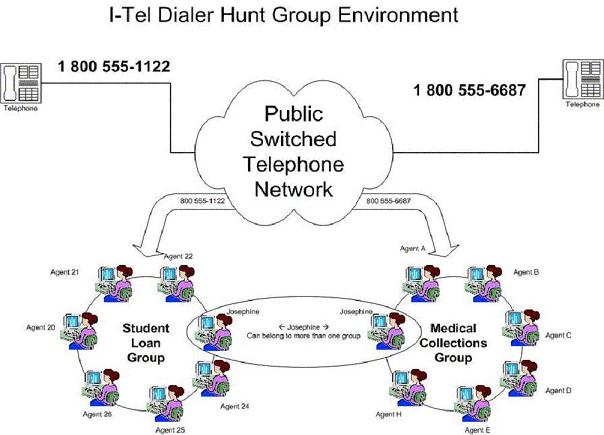The management of inbound calls is critical in a collections environment. Due to the amount of mail that is sent and the number of messages left on answering machines, an inbound call is usually a right party connect and a positive contact that must be handed quickly and correctly. With a host-based dialer, an inbound call can provide sufficient information (through the calling number) to identify an account on the collection database. This information can be used to route an account to the agent handling the account, or to a separate pool of people who are trained to handle incoming calls.
With RMEx’s dialing environment the following features are available :
- Agents and your dialing system can handle both inbound and outbound calls. In a predictive dialing environment, this is referred to as “blending”, and in the collection environment, an inbound call is usually given priority over an outbound call.
- You can set up ACD (Automatic call distributor) groups to handle different areas of your collection floor, different types of accounts or client types or clients.

- Depending on the way the system is set up, you will be able to selectively play greeting messages, different messages after normal working hours and customized messages when the caller has to be placed on hold because an agent is not immediately available. Some of these options may work in conjunction with IVR.
- One agent may belong to different ACD groups. In this case, as well as in a blended environment, there are different methods of notifying the agent as to the type of call. This will assist the agent with making the best decision about the incoming call.
- When an agent is unavailable or a call has been placed on hold for a long period, there are different options with regard to transferring the call to a different group of agents or sending the call to voice mail.
- DNIS support (Dialed number identification service) can be utilized. This support is provided by your telephone carrier and it allows you to identify the inbound number that was dialed by the debtor to call your collection center. This can be a toll free number for a specific group of agents, or a toll free or personal number (DID) associated with an individual collector. This inbound number formation can be used to route the call to the correct group of agents, to a specific collector or even to a specific dialing campaign.
- Automatic Number Identification (ANI) is utilized. This is similar to “Caller ID” that residential customers are accustomed to. The dialer is be able to capture this information, identify a matching account, and display the account information to the agent who received the call. If the number can not be matched to an account, it is still captured and once the account has been identified using one of RMEx’s search options, the phone number can be recorded anywhere on the account. Even if the account is transferred to another agent, the account information can be transferred along with the call. The result is that each person who handles the call does not have to ask the debtor for their account number or name again and again!
The challenges you will face in managing inbound calls are
- The ability to immediately access your collection data and use the results to allow the collector to quickly evaluate the call (before answering the call) and pull up the account information on their display. This becomes feasible only in an integrated dialer environment.
- Blending inbound calls with outbound campaigns to maintain high levels of productivity. When inbound calls are blended with an outbound campaign, there is often a loss in productivity as compared to a campaign that consisted of only outbound calls. I-Tel’s sophisticated blending is designed to keep productivity losses to a minimum.
I-Tel addresses both of these areas with its advanced dialer engine and an effectively integrated dialer and collection system.
